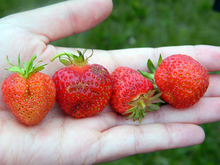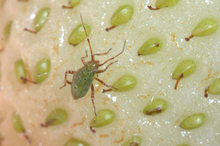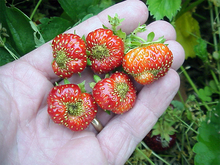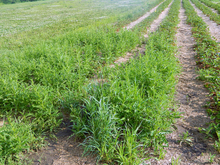Key points
- Several different issues are responsible for strawberry fruit being small or deformed.
- Supporting pollinators, protecting from frost/freeze, managing nutrients, managing diseases and insect pests, irrigating, and managing weeds all help increase fruit size and marketable yield.
Small and deformed fruit are common issues that reduce marketable yield and increase picking time. Several different factors can cause this. Before attempting to remedy the problem, first identify the cause.
Factors causing small or deformed fruit include:
- Poor pollination
- Tarnished plant bug
- Frost damage
- Weed pressure and overcrowding
- Old strawberry plantings
- Anthracnose infection on blossoms
- Poor nutrient management
- Dry soil
Poor pollination
Better pollination leads to larger fruit. Strawberries are called aggregate fruits because they have multiple ovules per fruit that need to be pollinated during bloom. These are observed as the many seeds (achenes) on the outside of the fruit.
The more ovules that are pollinated per fruit, the larger the fruit will be because the fruit tissue develops around the achene of each ovule that is pollinated. Therefore, if pollination is poor, fruit are likely to be smaller.
While strawberries do self-pollinate, self-pollination alone is not likely to pollinate all ovules on the blossom. Pollinators such as honeybees and bumblebees increase pollination and fruit size. Research has also shown that native bees and many species of flies also have a role in the pollination of strawberries.
Cool, rainy weather or broad-spectrum insecticide application during bloom can decrease pollination by reducing pollinator activity particularly of June-bearing varieties
Tarnished plant bug
Damage from tarnished plant bug (TPB) nymph feeding causes the fruit to be deformed and often smaller in size as a result. The damage is observed as a hard, seedy area at the tip of the berry. Tarnished plant bug is a common insect pest in our region.
Start scouting for TPB prior to bloom, when the flower buds are green or white, and continue scouting during bloom and fruit set. Manage weeds, which can harbor TPB, and do not plant clover or alfalfa nearby.
Since TPB feeds on strawberry flowers, growers should scout and apply insecticides at appropriate intervals throughout bloom. Select organic or synthetic insecticides according to recommendations in the Midwest Fruit Pest Management Guide and apply according to the label instructions.
TBP and frost damage can be easily mistaken for one another. Indicators that the damage is more likely due to TPB:
- The damage is concentrated at the tip of the berry, if the feeding was done during petal fall.
- Multiple berries on the same cluster are affected, rather than just the king fruit.
- Effective insecticides were not applied between early bloom and first picking.
- Scouting revealed the presence of TPB between early bloom and first picking.
- There was no frost from early bloom onward. The last frost was before bloom, when the buds were less sensitive to cold temperatures.
Frost damage
Frost damage can be mistaken with TPB damage. Both involve deformed fruit and a concentration of seeds on the affected portion of the fruit. However, frost damage has a less predictable injury pattern.
Indicators that injury may be due to frost, and not TPB:
- The grower has been monitoring and managing TBP.
- A frost or freeze occurred during bloom.
- The injury is occurring on the king fruit more than the other berries per cluster.
Tips for distinguishing frost damage from TPB:
- Consider whether the damage is localized to the tip of each berry, or more randomly placed.
- Check whether multiple fruit on the clusters are affected, or just the king berries.
- Consider whether TPB were found via scouting between early bloom and the first picking, and whether an effective insecticide program was used for TPB during petal fall and bloom.
- Think about the bud stage the plants were at during the latest frosts. More developed blossoms are more likely to get injured by frost.
- Think about whether you observed damage to the blossoms during bloom (black flower center).
Weed management
Weeds in strawberry fields compete with the crop for resources such as water and nutrients. Managing weeds in strawberries is so important that many growers in Minnesota send crews out weekly to hand-weed the beds.
Maintain good weed control throughout the entire season, even after harvest is complete. The health of the strawberry plants after harvest helps determine the following year’s yield and fruit quality.
Read more about strawberry weed management here.
Old strawberry beds
As a strawberry bed ages past Year 5, fruit size and yield tend to decrease. This effect is exacerbated if the bed is overcrowded, weedy, nutrient-depleted, or heavily infected by pathogens.
Even with good management practices in place, the peak of productivity is in Years 2 and 3 after planting. Plants then typically have 2 to 3 productive years before they begin losing vigor and deteriorating or senescing.
Therefore, growers should remove strawberry beds after 3 to 5 years rather than trying to extend their lifespan beyond peak productive years.
Anthracnose infections on blossoms
Anthracnose is a disease that infects strawberry blossoms, petioles, and stems in the early part of the season. Infection on the blossoms leads to small, hard, misshapen fruit, and, later, can increase fruit rot on ripe fruit.
When applying fungicides during bloom, include a product that is effective on anthracnose. This is particularly important if this disease has been an issue in the field previously, or if weather has been hot and wet.
Anthracnose is especially prevalent in hot, wet years. Fungicide applications during harvest will retroactively reduce infections on mature fruit but do not cure damage already done to infected fruit.
More information on controlling strawberry diseases.
Poor nutrient management
A number of macronutrients and micronutrients such as nitrogen, phosphorus, potassium, boron, and calcium are important for strawberry plant growth and fruit production. Insufficient levels of these nutrients in the soil, or an inability of the plants to take up these nutrients, may lead to small fruit size.
To prevent nutrient deficiencies, submit soil samples for nutrient testing prior to planting a new strawberry field.
Submit leaf samples for analysis each season to ensure that the plants are taking up the nutrient levels they require from the soil. See fertilizer recommendations for strawberries.
To interpret soil test results and learn more about the nutrient requirements of strawberries, download the Nutrient Management Guide for Commercial Fruit and Vegetable Growers.
Maintaining the health of strawberry beds
To keep strawberry beds healthy and productive through their peak fruitful years, practice good renovation, disease management, fertility, and weed management each year.
After removing a strawberry bed, rotate the field into a cover crop or a field crop such as pumpkins for at least two seasons before planting strawberries there again.
Reviewed in 2021







